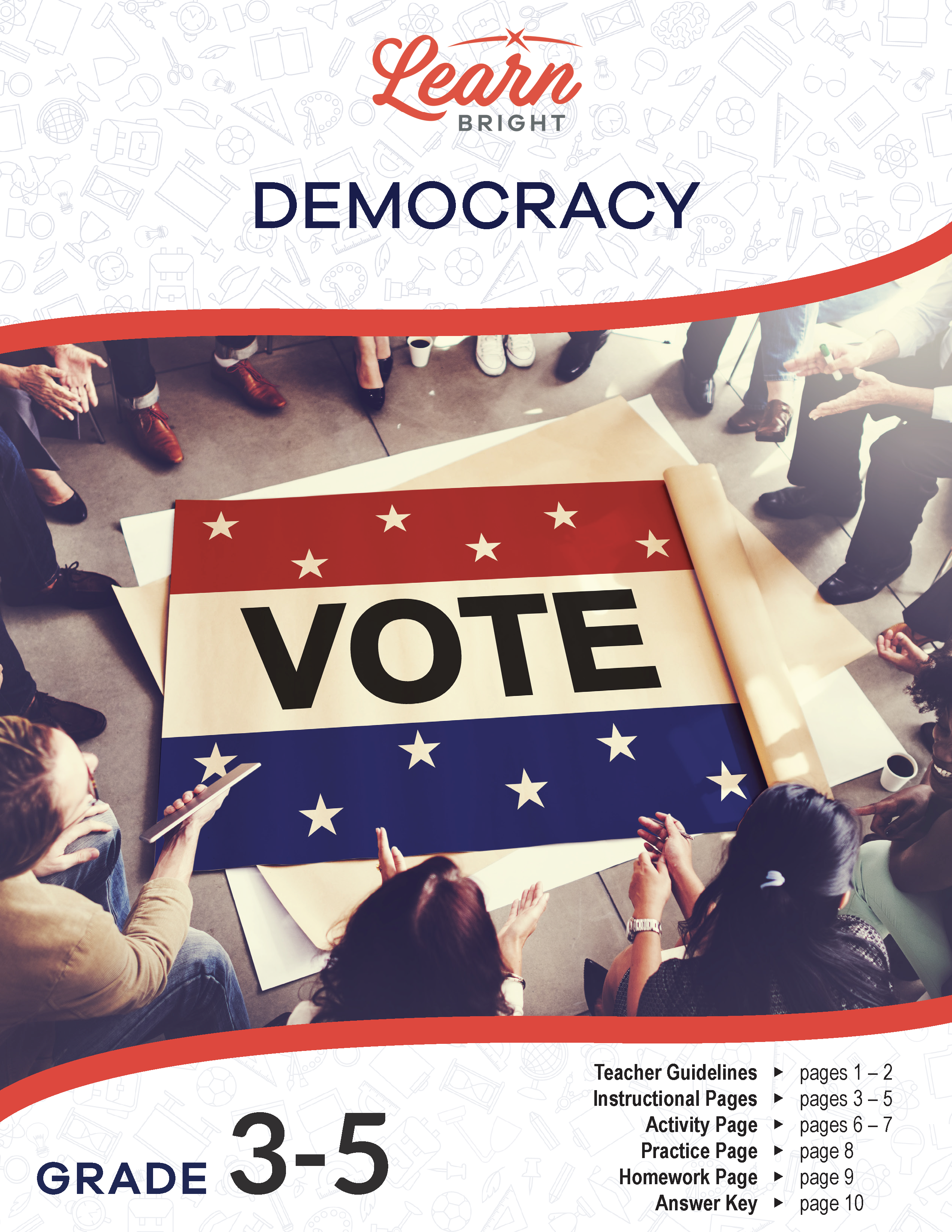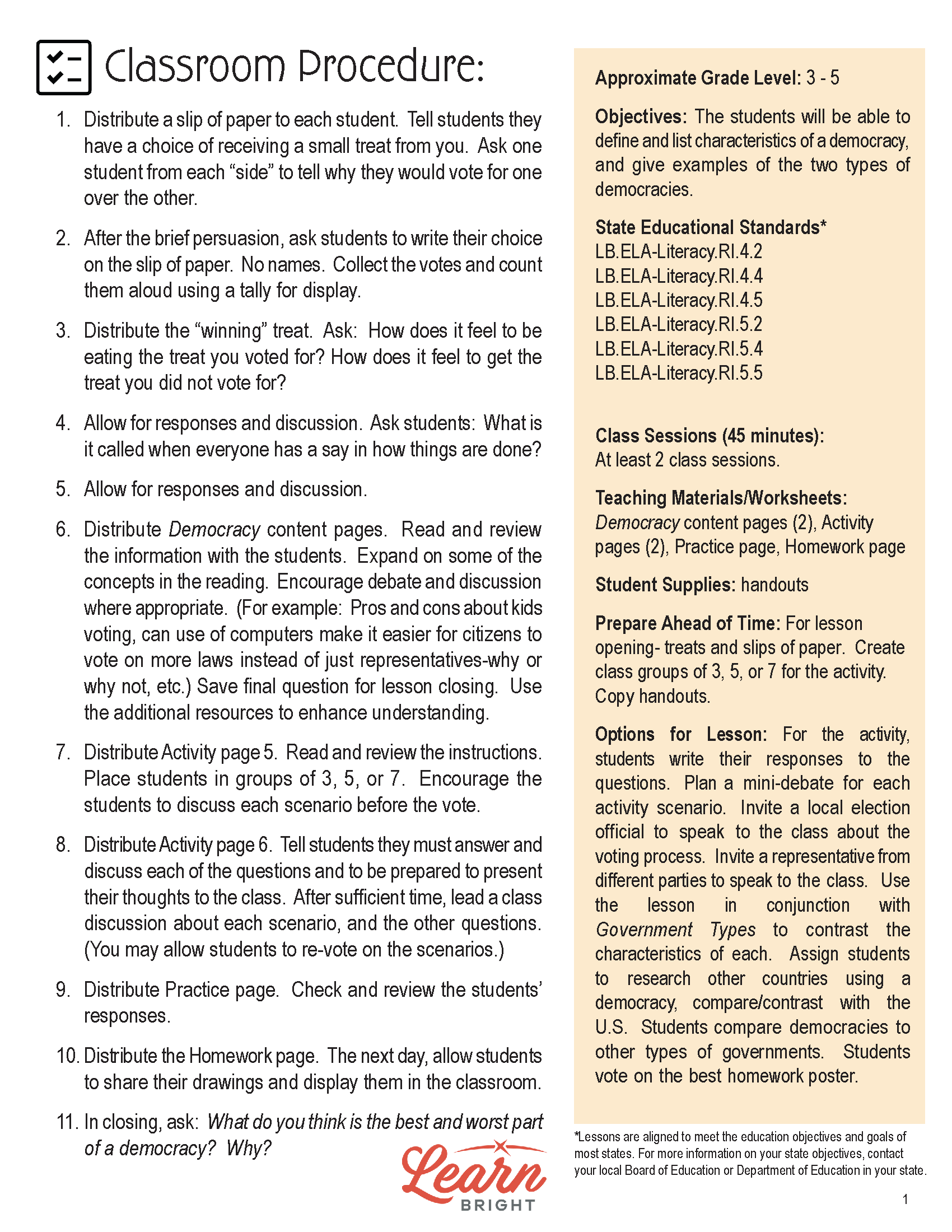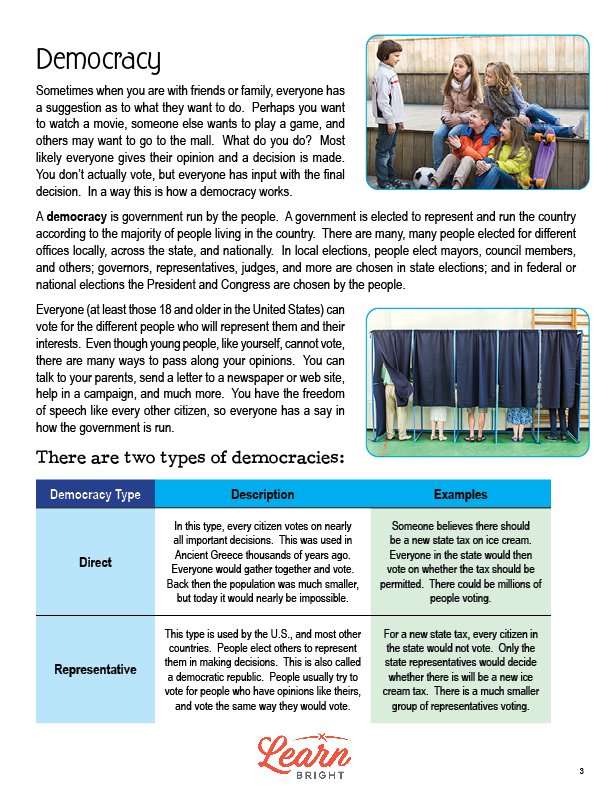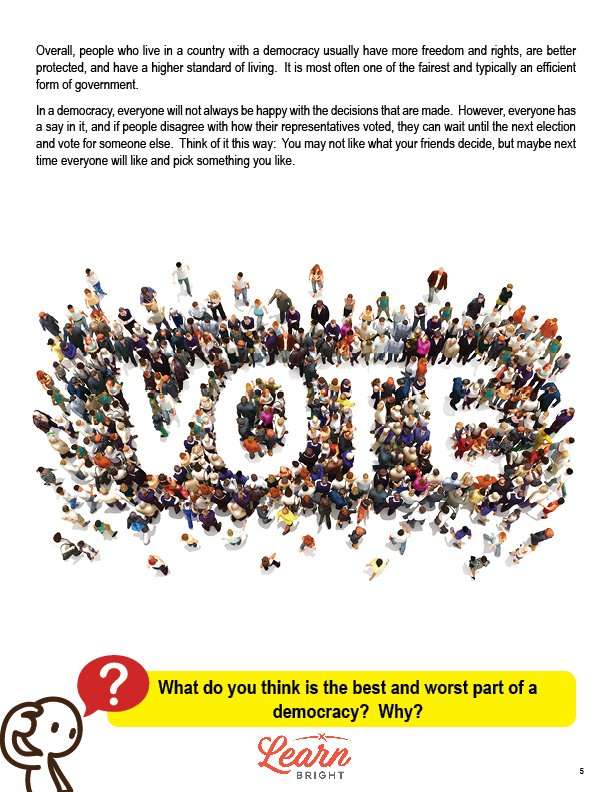Description
What our What is Democracy? lesson plan includes
Lesson Objectives and Overview: What is Democracy? introduces students to the concept of a democracy. This interactive lesson defines and lists the characteristics of a democracy, and gives examples of the two types of democracies while incorporating activities that solidify and generalize understanding. This lesson is for students in 3rd grade, 4th grade, and 5th grade.
Classroom Procedure
Every lesson plan provides you with a classroom procedure page that outlines a step-by-step guide to follow. You do not have to follow the guide exactly. The guide helps you organize the lesson and details when to hand out worksheets. It also lists information in the orange box that you might find useful. You will find the lesson objectives, state standards, and number of class sessions the lesson should take to complete in this area. In addition, it describes the supplies you will need as well as what and how you need to prepare beforehand. The only supplies you will need for this lesson are the handouts. To prepare for this lesson ahead of time, you can gather treats and slips of paper for the lesson opening, create groups of 3, 5, or 7 for the activity, and copy the handouts.
Options for Lesson
Included with this lesson is an “Options for Lesson” section that lists a number of suggestions for activities to add to the lesson or substitutions for the ones already in the lesson. The first optional addition to this lesson is to have students write down their responses to the questions on the activity worksheet. You could also plan a mini debate for each of the scenarios in the activity. You can invite a local election official or representatives from different political parties to speak to your class about the voting process and the government in general. If you want to expand this lesson, you could teach it in conjunction with the Government Types lesson to compare and contrast the characteristics of each type. You could also assign students different democratic countries to research and see how they differ from the United States. Students could also compare democracies to other forms of government. Finally, you could have students vote on the best homework poster.
Teacher Notes
The teacher notes page includes a paragraph with additional guidelines and things to think about as you begin to plan your lesson. It notes that this lesson might help students become interested in government. It could inspire the students to debate or have mock elections. This page also includes lines that you can use to add your own notes as you’re preparing for this lesson.
WHAT IS DEMOCRACY? LESSON PLAN CONTENT PAGES
Democracy
The What is Democracy? lesson plan includes three content pages. This lesson begins with a scenario in which a group of friends or family all want to do something different. One person wants to watch a movie, one person wants to play a game, and so on. In this case, everyone will most likely have a say in the final decision, even though they probably won’t actually vote on it. This is similar to how a democracy works.
A democracy is a form of government that the people run. In a democracy, the majority of the people living in the country elect the members of the government to represent them and run the country. They elect people at the local, state, and national levels. Local elections include mayors and council members; state elections include governors, representatives, and judges; and national elections include the President.
Almost everyone who is over the age of 18 in the United States can register to vote. They vote for people who represent them and their interests. People who are too young to vote can still make their voices heard by talking to their parents, sending a letter to a newspaper, volunteering for a campaign, and more. Freedom of speech means that you have a say in how people run the government.
Two Types of Democracies
There are two types of democracies: direct and representative. In a direct democracy, every citizen votes on most important decisions. They used this type in Ancient Greece, and everyone would gather together and vote. This was possible because the population was much smaller. This would be very hard to do today because there are so many people. The lesson provides an example of how this type of democracy works.
In a representative democracy, which is used by most modern democracies (including the United States), people elect others to represent them in making decisions. We also call this type a democratic republic. People living in this type of democracy tend to vote for people who have similar opinions to them, and who would vote the same way they would. The lesson also includes an example of how this type works.
Your school might be a good example of both of these types of democracy. Your teacher might have you vote on something for your class, and everyone gets a vote. That’s like a direct democracy. Your school might also have a student council who the student body voted for. These members vote during their meetings to represent the opinions of the class. That’s how a representative democracy works. In either type, we hear everyone’s voice and opinion.
Characteristics of a Democracy
The next section of this lesson covers several characteristics of democracies. The first are elections. Democracies have free elections, which means that every person has a vote. Some places have some restrictions, however. For example, you have to be 18 years old to vote in the United States. You can vote for whoever you want, and can even write in someone who is not on the ballot if you’d like.
The next characteristic of a democracy is majority rule. This means that the person who receives the most votes in an election wins. An important thing to note about this system is that it aims to protect the rights of individuals. An elected official cannot, for example, vote to change the individual right to freedom of religion.
The next characteristic is that some representatives have term limits. For example, the President of the United States can only serve two terms. Different states have different rules about term limits for their elected officials. All elected officials have limited power, partially due to the system of checks and balances. This ensures they don’t abuse their power while in office.
The fourth characteristic has to do with the citizens. In order for a democracy to work as intended, citizens must vote. They should understand who or what they’re voting for, learn about the issues, and voice their opinions. The United States does not allow all citizens to vote, but does allow most people to vote.
Democracies tend to have more rights for their citizens and have a higher standard of living. It is often an efficient form of government. While not everyone living in a democracy will be happy with every decision made, they will have a say. They can also make sure to vote.
WHAT IS DEMOCRACY? LESSON PLAN WORKSHEETS
The What is Democracy? lesson plan includes three worksheets: an activity worksheet, a practice worksheet, and a homework assignment. You can refer to the guide on the classroom procedure page to determine when to hand out each worksheet.
VOTING ACTIVITY WORKSHEET
Students will work in groups to complete this activity. They will read five scenarios and discuss them with their group. Next, they will secretly vote for one of two options related to each scenario. They will then discuss the answers to questions about each scenario after voting. Finally, they will share their thoughts and opinions with the class.
WHAT IS DEMOCRACY PRACTICE WORKSHEET
For this worksheet, students will circle the correct answer for 12 questions that relate to the lesson material. This will test students’ understanding of the lesson.
POSTER HOMEWORK ASSIGNMENT
The homework assignment asks students to create a poster encouraging people to vote. They can include drawings, images that they find in magazines or other sources, slogans, poems, or anything else they can think of. They will share their finished poster with the class.
Worksheet Answer Keys
This lesson plan includes an answer key for the practice worksheet. Answer keys for the activity worksheet and homework assignment are not included, as students’ answers will vary. If you choose to administer the lesson pages to your students via PDF, you will need to save a new file that omits these pages. Otherwise, you can simply print out the applicable pages and keep these as reference for yourself when grading assignments.










